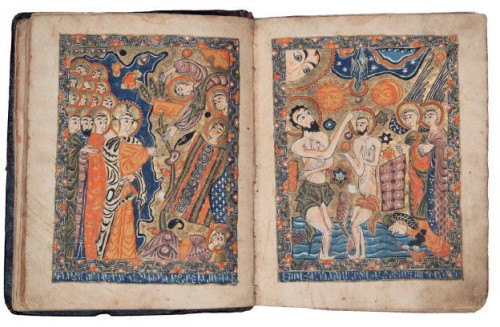The Pozzi Gospels by Hakob Jughayets’i will help the Museum tell the story of Armenia’s role as bridge between the East and West
The Toledo Museum of Art (TMA) has expanded its collection with its acquisition of “The Pozzi Gospels.” The 1586 Armenian manuscript by Hakob Jughayets’i — named after Jean Pozzi, a French collector and diplomat who owned the manuscript between 1936 and 1967 — is a superlative example of the rich Armenian artistic tradition and the region’s pivotal role in connecting the East to the West. Decorated with 46 full-page illustrations and numerous marginal paintings, “The Pozzi Gospels” was an ambitious project of that time and demonstrates cross-cultural and geographical mobility as well as the fluidity of techniques and methods during early modern globalization.
Ahmad Rafiei, a TMA Brian P. Kennedy leadership fellow, led efforts to acquire the work and considers it notable for its superlative quality. “Scholars note 'The Pozzi Gospels' are among the most sumptuous Armenian gospels ever made,” said Rafiei. “The aesthetic and cultural value of Hakob’s 1586 manuscript aligns with the Toledo Museum of Art’s commitment to quality. The acquisition advances the Museum’s goal to cultivate a culture of belonging with a collection that encompasses an inclusive narrative of art history.”
Although Hakob created his work in Armenia, he incorporated elements from other parts of the world, making his work unique for the time. The juxtaposition will allow TMA to situate stories about the movement of people, art and ideas that have contemporary relevance in historical context. Armenia has always played a pivotal role in connecting the East to the West. Given Armenia’s location, it was likely the site of the first religious conversations between the Christians and Zoroastrians. This convergence can be seen in Hakob’s work through the depiction of Christian iconography alongside Byzantine, Islamic and Buddhist design elements.
Hakob left his native Julfa, Armenia, an important trade city, to study and work in Vaspurakan, a well-known place for book production and home to the Van school, where biblical scenes are depicted symbolically with liturgical undertones. “The Pozzi Gospels” reveal Hakob’s innovative practice, which departed from some of the more established norms in the Armenian tradition of illuminated manuscripts. Hakob’s innovations are visible in the expressive representation of personalities, particularly the portraits of God. Marginal decorations in Hakob's gospels are more vibrant and less geometric than the works of his contemporaries, including in his rendering of halos and floral elements. The artist also introduced new, syncretic iconographies, such as in the biblical scene “Adam and Eve in the Garden,” which features figures with Buddhist-style halos. Innovatively borrowing Buddhist and Islamic iconographies, Hakob narrates a Christian story through the gospels — an unprecedented approach in his cultural and artistic tradition.
When Hakob finished “The Pozzi Gospels” in 1586 he was a well-known, 36-year-old artist. The work is one of nine extant illuminated manuscripts by Hakob. It is distinguished from other manuscripts Hakob made after 1587 by the energetic drawings and vivid colors. It was also created entirely by Hakob while other works such as the T’vink manuscript (1587) contain marginal illustrations by other artists. Also, in Vaspurakan and New Julfa, Hakob had several pupils helping him with main images and marginal scenes.
